Wireless Backhaul Power Supplies
This example reference circuit provides all the power-supply rails and power sequencing necessary to power Xilinx® ZU9/15 Wireless Backhaul power supplies. The module accepts 12V input voltage and generates seven power. The VCCPINT output is set to 0.85V with 3A output-current capability by using the MAX15303 step-down switching regulator. The VCCINT output is set to 0.72V with 12A output current capability by using the MAX20730 PMBus™ step-down switching regulator. Both VMGTAVCC and VMGTAVTT output voltages are generated from the MAX17509 dual step-down regulator. VMGTAVCC is set to 0.9V with 2A capability and the VMGTAVTT is set to 1.2V with 2A current capability. Both VMGTAVCC and VMGTAVTT output voltages have less than 10mV output ripple, which meet the ripple requirements. Another MAX17509 IC generates the VAUX and VMGTAVCCAUX output voltages. VAUX is capable of delivering 1A at 1.8V and VMGTAVCCAUX is capable of delivering 1A at 1.8V. The MAX17541G generates the VCCOPIO output voltage. VCCOPIO is capable of delivering 0.5A at 3.3V.
The power module provides extremely compact, high-efficiency power solutions with high-precision output voltages and excellent transient response.
Features
- InTune™ Digital PoL SMPS MAX15303
- 600kHz Switching Frequency
- 12V Input Voltage
- 0.85V at 3A (VCCPINT)
- Integrated Buck Regulator SMPS MAX20730
- 400kHz Switching Frequency
- 12V Input Voltage
- 0.72V at 12A (VCCINT), 10mV ripple
- Dual Buck Regulator SMPS MAX17509
- 1MHz Switching Frequency
- 12V Input Voltage
- 0.9V at 2A (VMGTAVCC), 10mV ripple
- 1.2V at 2A (VMGTAVTT), 10mV ripple
- Dual Buck Regulator SMPS MAX17509
- 1MHz Switching Frequency
- 12V Input Voltage
- 1.8V at 1A (VAUX)
- 1.8V at 1A (VMGTAVCCAUX)
- Buck Regulator SMPS MAX17541G
- 600kHz Switching Frequency
- 12V Input Voltage
- 3.3V at 0.5A (VCCOPIO)
详情介绍
VCCINT (0.72V) Output:
The MAX20730 step-down regulator accepts 12V input and generates 0.72V output with 12A current capability. The switching frequency is set to 400kHz. The output voltage is set by resistors R104 (1.27k) and R105 (11.5k). The output voltage can be changed by changing R104 and R105. Refer to the Output-Voltage Setting section of the MAX20730 data sheet. The output voltage, switching frequency, and current limit can also be monitored and programmed using a PMBus serial connection using Maxim's PowerTool™ software. This gives the user the ability to margin their designs during operation.
This regulator includes overcurrent (OCP) and overtemperature protection (OTP). It has 0.2% load regulation at full load and excellent transient response.
VCCINT Switching Frequency
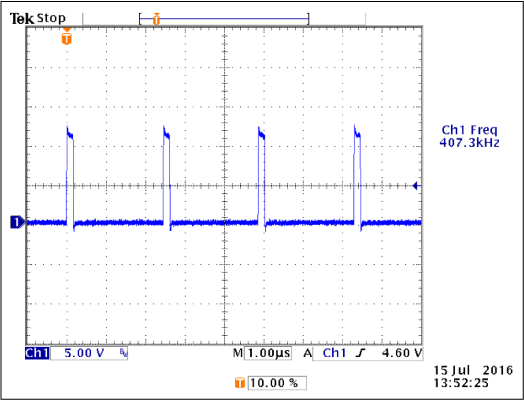
VCCINT Accuracy (at no load) and Load Regulation (at full load)
| Load (A) | VOUT (V) measured | % error |
|---|---|---|
| 0 | 0.7215 | 0.2 |
| 12 | 0.7215 | 0.2 |
VCCINT Transient Response (1A to 10A load)
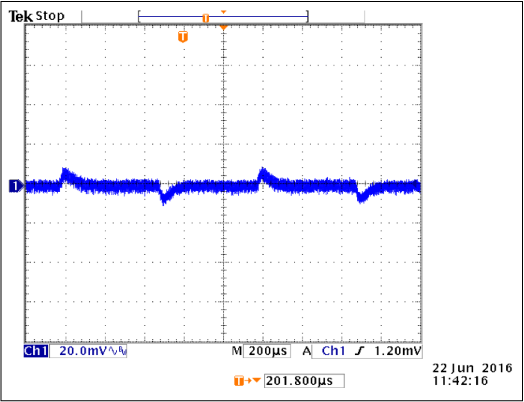
VCCINT Output Ripple (12A load)
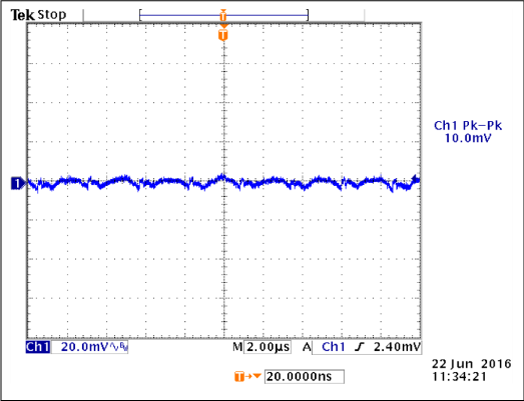
VCCPINT (0.85V) Output:
The MAX15303 step-down regulator accepts 12V input and generates 0.85V output with 3A current capability. The switching frequency is set to 600kHz. The output voltage is set by resistor R203 (9.53k). The output voltage can be changed by changing R203. Refer to the Output-Voltage Setting section of the MAX15303 data sheet. The output voltage, switching frequency, and current limit can also be monitored and programmed using a PMBus serial connection using Maxim’s PowerTool software. This gives the user the ability to margin their designs during operation. This regulator includes overcurrent (OCP) and overtemperature protection (OTP). It has 0.12% load regulation at full load and excellent transient response.
VCCPINT Switching Frequency
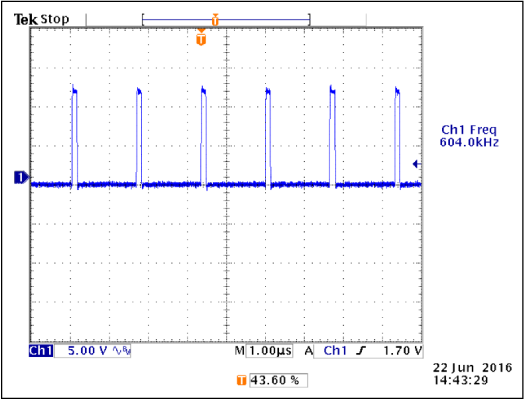
VCCPINT Accuracy (at no load) and Load Regulation (at full load)
| Load (A) | VOUT (V) measured | % error |
|---|---|---|
| 0 | 0.849 | 0.12 |
| 3 | 0.849 | 0.12 |
VCCPINT Transient Response (1A to 3A load)
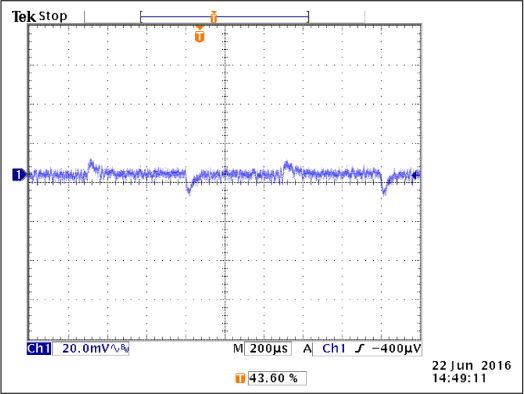
VCCPINT Output Ripple (3A load)
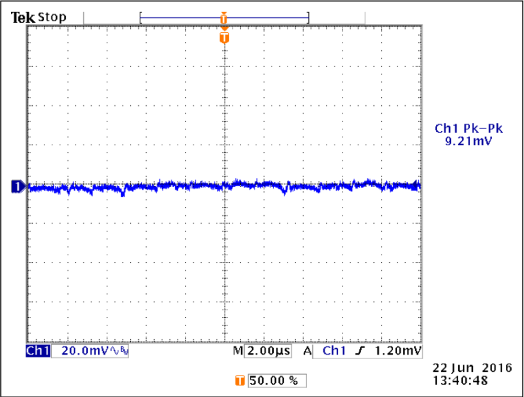
VMGTAVCC (0.9V) and VMGTAVTT (1.2V) Outputs:
The MAX17509 dual step-down regulator accepts 12V input and generates 0.9V and 1.2V outputs with 2A current capability for each output. The switching frequency is set to 1MHz. The 0.9V output voltage is set by resistors R310 (115k) and R311 (4.75k). The 1.2V output voltage is set by resistors R314 (6.81k) and R315 (75k). Both outputs can be changed by changing the feedback resistors. Refer to the Output-Voltage Setting section of the MAX17509 data sheet. The MAX17509 includes overcurrent (OCP) and overtemperature protection (OTP). It has excellent load regulation at full load and transient response. Both outputs have better than 10mV output ripple.
VMGTAVCC Switching Frequency
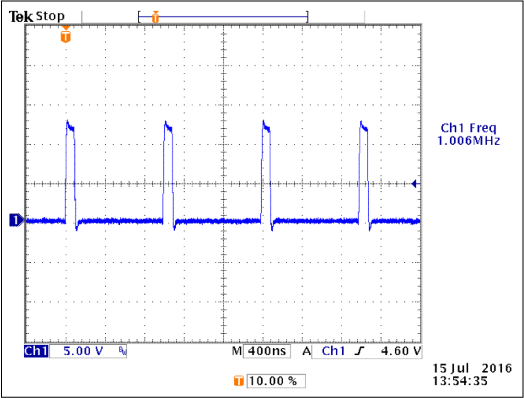
VMGTAVCC Accuracy (at no load) and Load Regulation (at full load)
| Load (A) | Vout (V) measured | % error |
|---|---|---|
| 0 | 0.904 | 0.45 |
| 2 | 0.904 | 0.45 |
VMGTAVCC Transient Response (1A to 2A load)
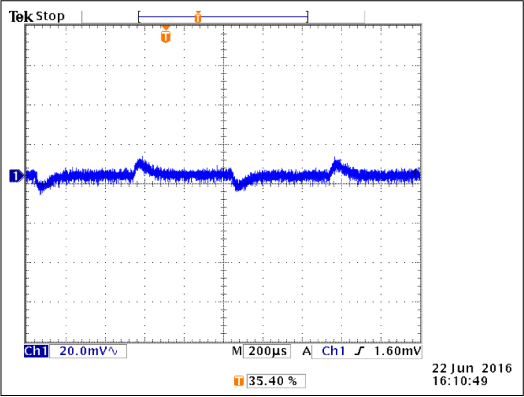
VMGTAVCC Output Ripple (2A load)
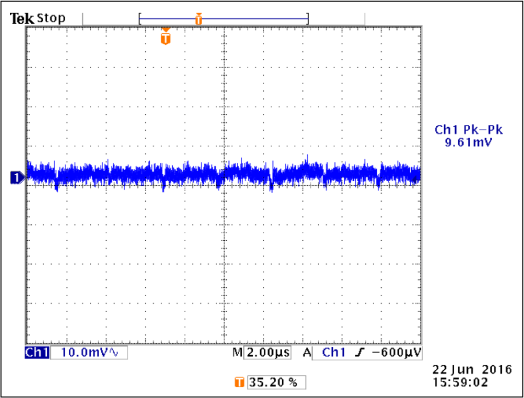
VMGTAVTT Switching Frequency
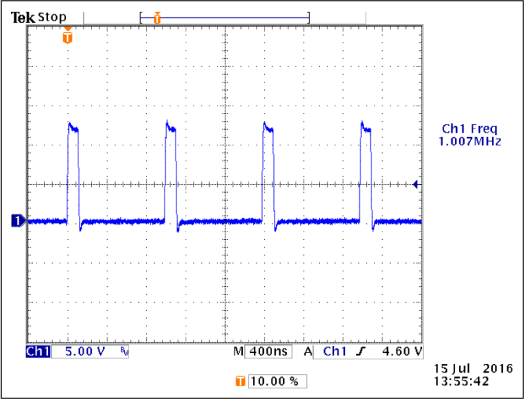
VMGTAVTT Accuracy (at no load) and Load Regulation (at full load)
<
| Load (A) | VOUT (V) measured | % error |
|---|---|---|
| 0 | 1.203 | 0.25 |
| 2 | 1.203 | 0.25 |
VMGTAVTT Transient Response (1A to 2A load)
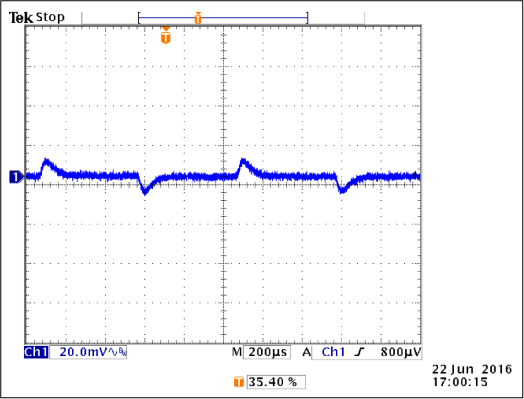
VMGTAVTT Output Ripple (2A load)
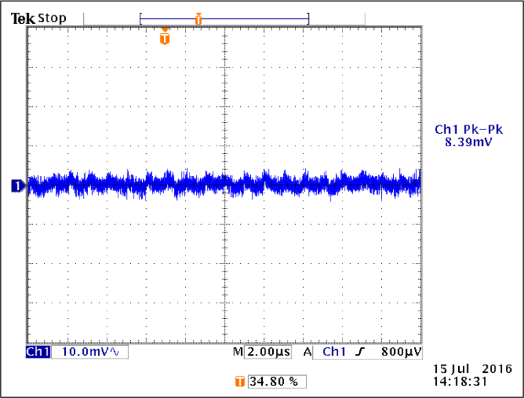
VAUX (1.8V) and VMGTAVCCAUX (1.8V) Outputs:
The MAX17509 dual step-down regulator accepts 12V input and generates 1.8V and 1.8V outputs with 1A current capability for the 1.8V and 1A current capability for the 1.8V output. The switching frequency is set to 1MHz. The 1.8V output voltage is set by resistors R410 (40.2k) and R411 (11.8k). The 1.8V output voltage is set by resistors R414 (11.8k) and R415 (40.2k). Both outputs can be changed by changing the feedback resistors. Refer to the Output-Voltage Setting section of the MAX17509 data sheet. The MAX17509 includes overcurrent (OCP) and overtemperature protection (OTP). It has excellent load regulation at full load and transient response. Both outputs have better than 10mV output ripple.
VAUX Switching Frequency
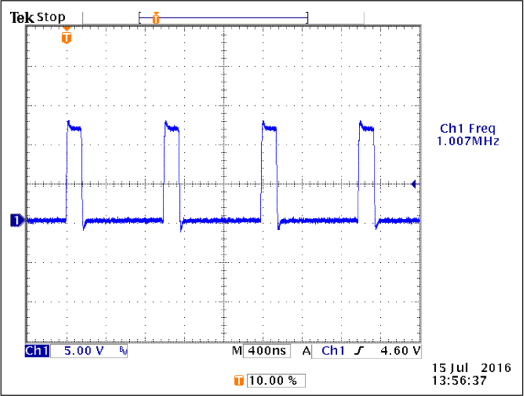
VAUX Accuracy (at no load) and Load Regulation (at full load)
| Load (A) | VOUT (V) measured | % error |
|---|---|---|
| 0 | 1.792 | 0.45 |
| 1 | 1.791 | 0.5 |
VAUX Transient Response (0A to 1A load)
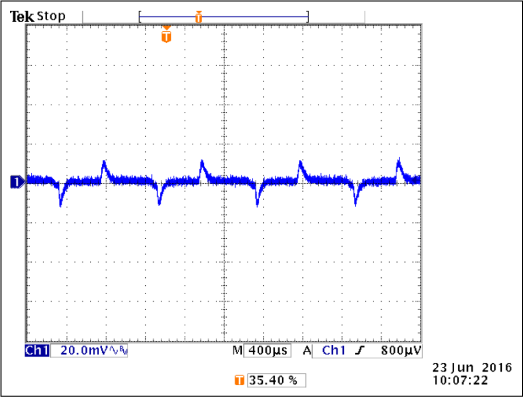
VAUX Output Ripple (1A load)
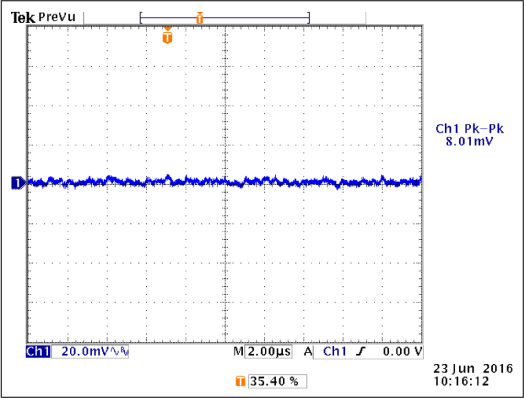
VMGTAVCCAUX Switching Frequency
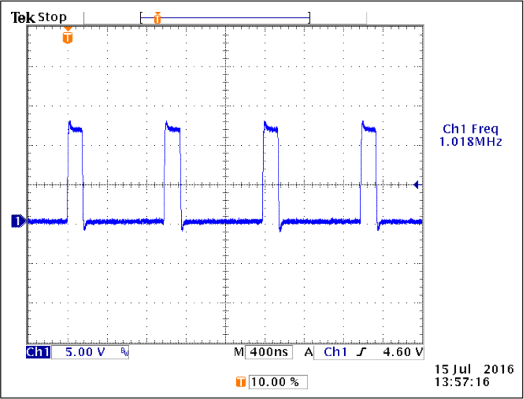
VMGTAVCCAUX Accuracy (at no load) and Load Regulation (at full load)
| Load (A) | Vout (V) measured | % error |
|---|---|---|
| 0 | 1.792 | 0.5 |
| 1 | 1.792 | 0.5 |
VMGTAVCCAUX Transient (0A to 1A load)
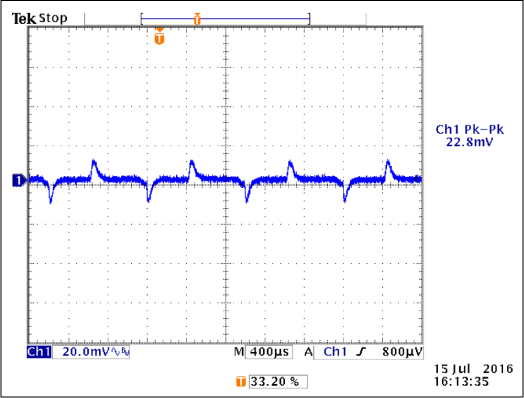
VMGTAVCCAUX Output Ripple (1A load)
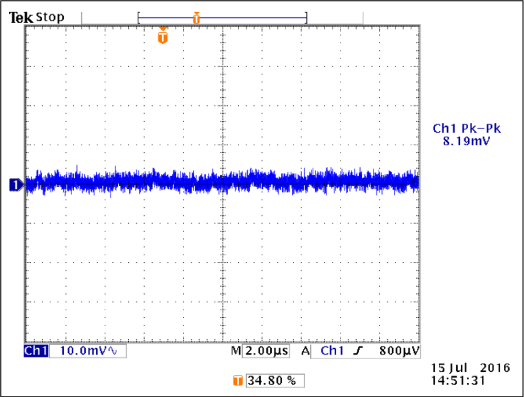
VCCOPIO (3.3V) Output:
The MAX17541G step-down regulator accepts 12V input and generates 3.3V output with 0.5A current capability. The switching frequency is set to 600kHz. The output voltage is set by resistors R704 (48.7k) and R705 (18.2k). The output voltage can be changed by changing R704 and R705. Refer to the Output-Voltage Setting section of the MAX17541G data sheet . The MAX17541G includes overcurrent (OCP) and overtemperature protection (OTP). It has 0.1% load regulation at full load and excellent transient response.
VCCOPIO Switching Frequency
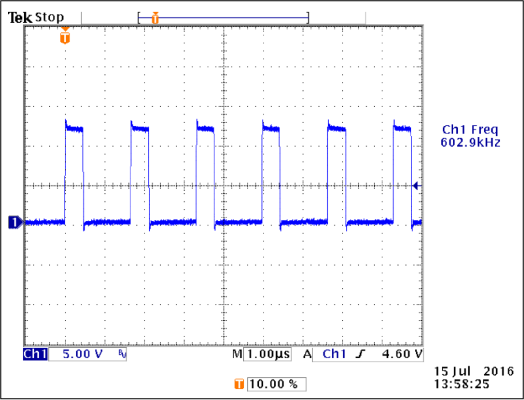
VCCOPIO Accuracy (at no load) and Load Regulation (at full load)
| Load (A) | Vout(V) measured | % error |
|---|---|---|
| 0 | 3.29 | 0.3 |
| 0.5 | 3.29 | 0.3 |
VCCOPIO Transient Response (0A to 0.5A load)
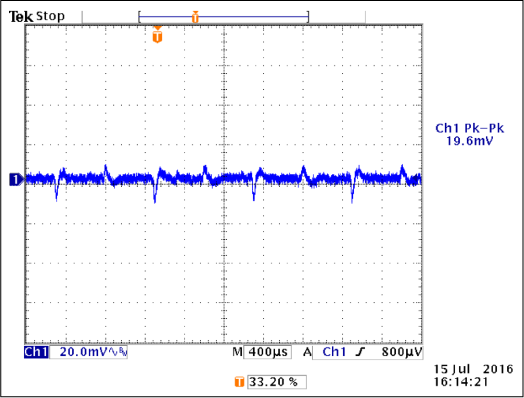
Power Sequencing:
Power Sequencing has een achieved by using the power good and enable signals to sequence the output voltages. Output voltages VCCINT, VCCPINT and VMGTAVCC power up first, followed by VMGTAVTT, VAUX and VMGTAVCCAUX and VCCOPIO. An I2C, SMBus, or PMBus sequencer such as the MAX34440 can also be used for voltage monitoring and power sequencing.
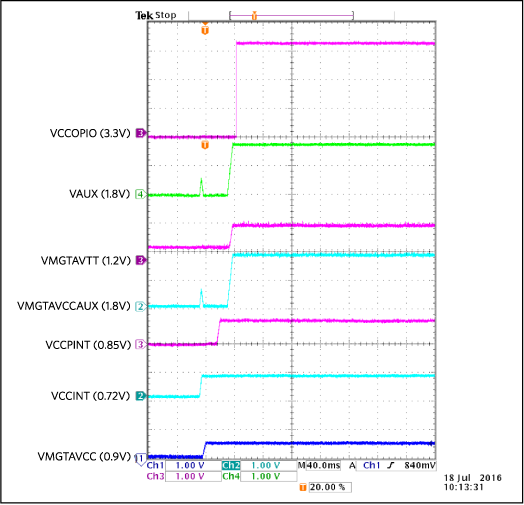
InTune is a trademark of Maxim Integrated Products, Inc.
PMBus is a trademark of SMIF, Inc.
PowerTool is a trademark of Maxim Integrated Products, Inc.
Xilinx is a registered trademark and registered service mark of Xilinx, Inc.


